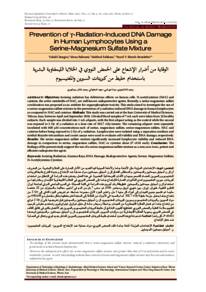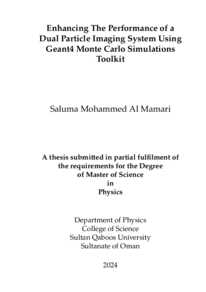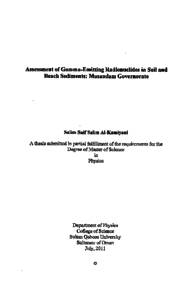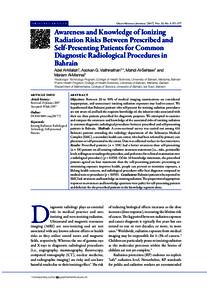Document
Prevention of γ-radiation-induced DNA damage in human lymphocytes using a serine-magnesium sulfate mixture.
Identifier
doi: 10.18295/squmj.2016.17.02.005
Contributors
Other titles
الوقاية من أضرار الإشعاع على الحمض النووي في الخلايا الليمفاوية البشرية باستخدام خليط من كبريتات السيرين والمغنيسيوم
Publisher
College of Medicine, Sultan Qaboos University.
Gregorian
2017-05
Language
English
Subject
English abstract
Ionising radiation has deleterious effects on human cells. N-acetylcysteine (NAC) and
cysteine, the active metabolite of NAC, are well-known radioprotective agents. Recently, a serine-magnesium sulfate
combination was proposed as an antidote for organophosphate toxicity. This study aimed to investigate the use of
a serine-magnesium sulfate mixture in the prevention of γ-radiation-induced DNA damage in human lymphocytes
as compared to NAC and cysteine. Methods: This study was carried out at the Iran University of Medical Sciences,
Tehran, Iran, between April and September 2016. Citrated blood samples of 7 mL each were taken from 22 healthy
subjects. Each sample was divided into 1 mL aliquots, with the first aliquot acting as the control while the second
was exposed to 2 Gy of γ-radiation at a dose rate of 102.7 cGy/minute. The remaining aliquots were separately
incubated with 600 μM concentrations each of serine, magnesium sulfate, serine-magnesium sulfate, NAC and
cysteine before being exposed to 2 Gy of γ-radiation. Lymphocytes were isolated using a separation medium and
methyl-thiazole-tetrazolium and comet assays were used to evaluate cell viability and DNA damage, respectively.
Results: The serine-magnesium sulfate mixture significantly increased lymphocyte viability and reduced DNA
damage in comparison to serine, magnesium sulfate, NAC or cysteine alone (P <0.01 each). Conclusion: The
findings of the present study support the use of a serine-magnesium sulfate mixture as a new, non-toxic, potent and
efficient radioprotective agent.
Member of
Resource URL
Arabic abstract
الهدفة الإشعاعات المؤينة مثل الأشعة جاما والأشعة السينية لها العديد من الآثار الضارة على الخلايا البشرية. من المعروف N-Acetylcysteine: Cysteine. ان آل ن أسيتيل سيستئين والسيستئين، والمستقلب الفعال لل ن أسيتيل سيستنين، مواد حماية ضد الإشعاع، وحديثا اقترح خليط كبريتات المغنيسيوم والسيرين كمضاد للتسمم بمبيدات الآفات الفوسفاتية العضوية في هذا العمل، وهدفت هذه الدراسة الي التحقق من استخدام كبريتات سيرين المغنيسيوم لمنع التأثيرات الضارة للإشعاع جاما على الحمض النووي في الخلايا الليمفاوية للإنسان ومقارنتها مع استخدام آل ن أسيتيل سيستنين والسيستين، الطريقة، وقد أجريت هذه الدراسة في كلية الصيدلة، في الحرم الجامعي الدولي لجامعة ايران العلوم الطبية، طهران، إيران، بین شهری أبريل وسبتمبر 2016. ثم سحب 7 مل من الدم في أنابيب معالجه بالسيترات من 22 شخصا سليما، تم تقسيم جميع العينات إلى أجزاء كل منها امل واعتبر الجزء الأول مجموعه ضابطه، تم تعريض الجزء الثاني إلى G7 2 من اشعاع جاما بمعدل جرعة دقيقة /Gy-71 102. أما بالنسبه الى الأجزاء من الثالثة إلى السابعة فتم حفظها بشكل منفصل . AM 600 من مع مواد السيرين وكبريتات المغنيسيوم وسيرين كبريتات المغنيسيوم، آل ن أسيتيل سيستنين، والسيستين قبل تحريضها على GyJ 2 غراي من إشعاع جاما. ثم فصل الخلايا الليمفاوية من العينات بواسطة وسيط و مادة ال مثيل تيازول تیترازوليوم واستخدم مقياس كوميت لتقييم سلامة الخلية والحمض النووي النتائج: أظهرت النتائج أن خليط كبريتات المغنيسيوم والسيرين هو الأفضل بكثير في تقليل التلف الحمض النووي وحيوية الخلايا الليمفاوية من مركبات السيرين، كبريتات المغنيسيوم، ال ن أسيتيل سيستنين ، والسيستين لوحدها (0.01 > P، كل واحد) الخلاصة تدعم نتائج هذا البحث أستخدام خليط كبريتات المغنيسيوم والسيرين كعامل جديد قوي، وفعال في الحماية صد خطر الإشعاع.
Category
Journal articles




